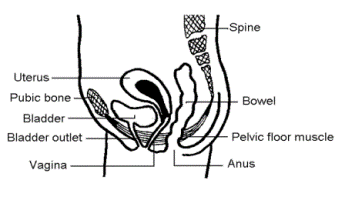What
Are Pelvic Floor Muscles – The
Basics
What Are Pelvic
Floor Muscles
The pelvic floor muscles are
internal muscles which aren’t visible either when relaxed or contracted. They form a broad sling
of muscle between the legs stretching from side to side across the floor of the pelvis from the
pubic bone in front to the coccyx, which is the base of your spine at the back.
 The pelvic floor keeps all your internal organs,
bladder, womb, bowel and uterus in place. The openings from your bladder (urethra), your
bowels (rectum) and your womb (vagina) all pass through your pelvic floor. To keep the pelvic
floor strong, you need to exercise it. The pelvic floor keeps all your internal organs,
bladder, womb, bowel and uterus in place. The openings from your bladder (urethra), your
bowels (rectum) and your womb (vagina) all pass through your pelvic floor. To keep the pelvic
floor strong, you need to exercise it.
The Pelvic Floor is responsible for a number of things. It is used to control wind and when
"holding on" with your bowels also supporting the bladder to help it stay closed and stop the flow
of urine.
It has an important sexual
function, helping to increase sexual awareness both for yourself and your partner during sex.
It actively tenses when you
cough or sneeze to help avoid any urine leakage. When the muscles are not working effectively
you may suffer from a leaking bladder and an urgent or frequent need to pass urine which is
termed as urinary incontinence.
The consequences of weakened pelvic floor muscles may include urinary or bowel
incontinence. Both of which can be helped by therapeutic strengthening of these
muscles.
Strong pelvic floor muscles
can support the extra weight of pregnancy, help in the second stage of labour and, by increasing
your circulation, assist in healing the perineum between the anus and vagina after
birth.
These muscles can become weaker for a number of reasons including pregnancy,
childbirth, ageing and being overweight.
Pelvic floor or Kegel exercises as they often called help to regain pelvic floor
muscle strength and endurance.
When done regularly, these exercises can
help to prevent stress incontinence and possibly prolapse in later life.
The Baby Belly Fat Loss Plan includes an entire
eBook devoted to pelvic floor recovery and repair. Containing illustrations and a full
description showing exactly 'what are pelvic floor muscles', simple
instructions on how to perform specific exercises and test pelvic floor strength plus other
essential tips and advice.
If you want to lose baby weight, burn fat, tone up and fit in
to your pre pregnancy clothes in just 8 weeks from now, I recommend you read every
word of this next page -
lose baby weight now
|

